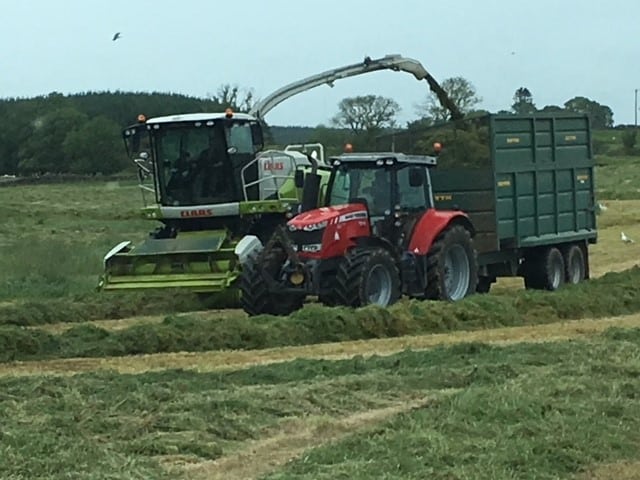Scottish livestock producers are being advised to plan for building up feed supplies now to help avoid a difficult winter.
Using cumulative positive ground temperatures from 1 January, the livestock team at SAC Consulting (part of Scotland’s Rural College) predicted a three-week delay to spring turnout.
Kirsten Williams, who heads up the team, has outlined some of the options recommended to producers:
Forage crops
With challenging ground and weather conditions, there are currently few forage crops in the ground. Once we approach the longest day (21 June), our growing days will start to become shorter, which will have an effect on their yield potential. An alternative option may be to grow a quicker-growing crop such as Italian Ryegrass, which can be cut for extra silage or grazed.
Don’t delay cutting silage
The heading date of grass is largely determined by the variety and day length, this is usually between mid-May and mid-June. The eight weeks prior to this heading is when the largest growth occurs, and when fields tend to be closed up for silage. When the grass heads, the digestibility of the crop declines, meaning it is essential not to delay cutting the grass. It will mean a lower yield, but of greater quality. Once cut, ensure the recommended rate of nitrogen is applied to the aftermath, to maximise the growth for the second cut or follow up grazing.
Wholecrop
Another option to increase feed supplies is to cut headlands of cereal fields pre-harvest as wholecrop and ensiling it. There may be options to buy standing crops, or to work collaboratively. For example, establish a catch crop such as stubble turnips to graze in the winter, to away winter cattle on an arable farm. For the arable producer, these provide an income and a way of returning organic matter and nutrients back to the arable land. Catch crops can also be sown after silage has been cut, provided there is moisture in the ground.
Minimise wastage
To minimise waste ensure silos are well sheeted and consider using an extra layer of wrap-on bales. With wholecrop, ensure any pits are fully baited against vermin as soon as they are filled.
Purchasing additional feed now
Stocks of hay, for example, can be purchased now, and there are plentiful supplies of stock feed potatoes, which could be ensiled in layers with grass silage to help extend forage supplies next winter.
Reduce stock numbers to be overwintered
Beef Consultant Lesley Wylie advises that, if you are currently more than 30 per cent down on your normal forage supplies, consider selling some or even all growing stock now while store prices are high.
With forage shortages being a UK-wide problem, it is likely that excess numbers of stock will be sold store in the autumn and prices respond accordingly. Options include:
- Giving cows top priority for grazing during the breeding period and, if necessary, supplement;
- Selling store cattle to free up grazing for breeding stock;
- To free up grazing for other stock, consider finishing cattle intensively indoors as reduced grazing period may make finishing at grass difficult;
- Creep feed calves earlier to take pressure off cows and ensure the calves’ live weight is adequate for early weaning, and they are strong enough to sell store soon after weaning;
- Sell any barren cows as soon as possible once weaned;
- If grass is falling behind, wean lambs earlier and either get them away to store or move them indoors and intensively finish. This will release grass and help ewes regain condition before the next breeding season;
- Identify options for away wintering stock or the possibility of outwintering breeding stock.
Alternatives to straw bedding
There are a number of bedding alternatives available which, when used as a base layer, aid drainage and reduce the amount of straw required. SAC Consulting beef specialist Sarah Balfour said: “Some products require a period of drying out so now is the time to speak to local wood processors and garden waste recycling companies (made from shredded compost or composted organic material including grass and hedge clippings), by using a base layer at housing means straw will stay drier for longer, reducing the amount required.”
Rape, pea and bean straws are often not considered as bedding due to their physical structure. However, using a courser, stemmy straw as a base layer under traditional cereal straw gives good drainage. Total straw usage can be reduced by approximately 30 per cent.
Consider options to save straw, an effective way to do this is using scraped feed passageways, and scraping out the slurry into adequate storage. This can also reduce straw usage by 30 per cent.
Other ways to save straw include;
- Shed maintenance and ventilation – ensure water troughs and guttering are not leaking and buildings are well ventilated;
- Get straw in dry;
- Consider tube lining or wrapping two layers around bales.
For more advice and to stay up to date with the latest news in the beef and sheep sector, sign up to Sheep and Beef News by emailing [email protected] or visiting ww1.sruc.ac.uk/sbnews






